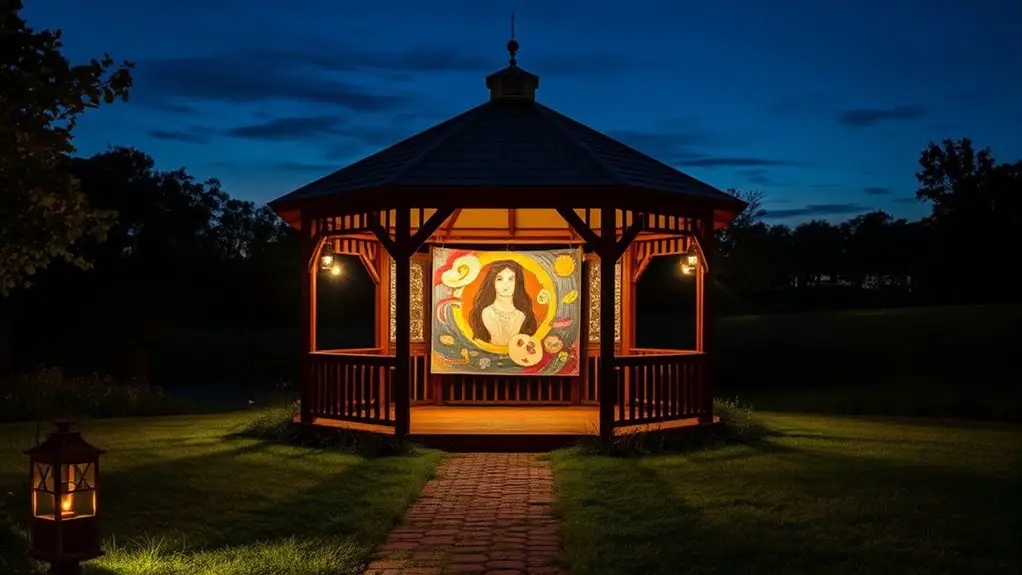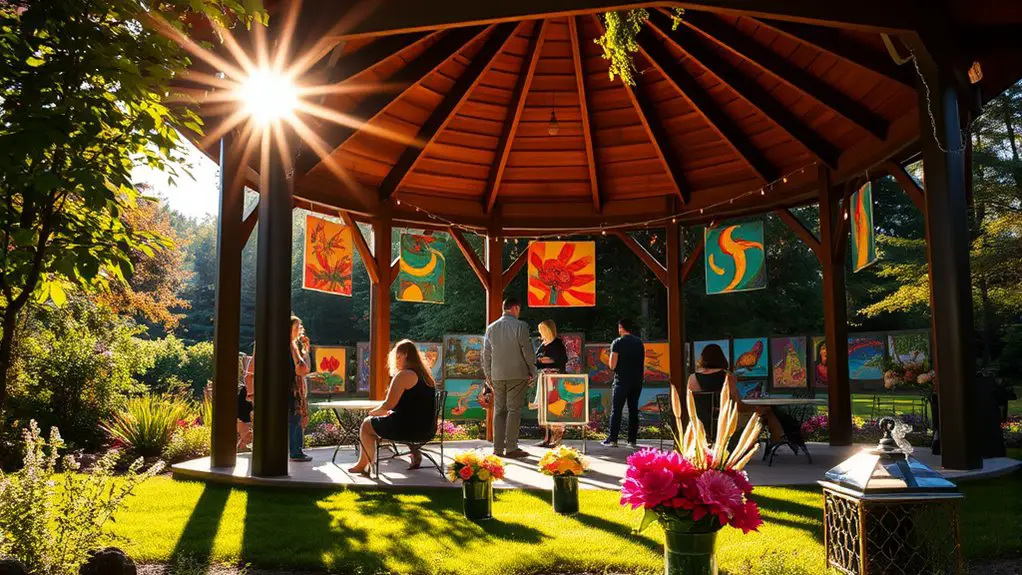Using a gazebo as a pop-up art gallery can transform any outdoor space into an enchanting artistic hub. Choose a durable gazebo to protect your artwork while creating an inviting atmosphere. Design the layout with careful consideration, ensuring smooth traffic flow and thematic displays. Proper lighting is essential for highlighting your pieces and enhancing the experience. By promoting the event and engaging the community through workshops, you can create a vibrant cultural connection. Discover further insights on maximizing this unique space.
Choosing the Right Gazebo for Your Art Gallery

When considering how to choose the right gazebo for your art gallery, have you thought about the atmosphere and experience you want to create? The size selection is paramount; you’ll want a space that can comfortably accommodate both your artwork and your visitors. A gazebo too small might feel cramped, while one too large could diminish the intimacy you’re aiming for.
Material durability is another vital factor. Choose materials that withstand the elements, ensuring your artwork is protected from sun and rain. A sturdy frame combined with weather-resistant fabric can create a welcoming environment, inspiring creativity and conversation. Additionally, consider the essential features that can enhance the overall experience, such as proper lighting for your artwork.
Ultimately, envision how the gazebo will complement your artistic vision. Whether you’re showcasing vibrant paintings or delicate sculptures, your choice should enhance the experience, inviting freedom of expression and exploration. Balancing size and durability will help you craft a unique atmosphere, setting the stage for a memorable art event.
Designing the Layout of Your Pop-Up Gallery
As you explore designing the layout of your pop-up gallery, it’s crucial to reflect on how the arrangement of space can influence the visitor experience. Thoughtful gallery flow and effective space utilization are fundamental to create an inviting atmosphere. Here are four key elements to contemplate:
Designing your pop-up gallery layout is essential for enhancing visitor experience through thoughtful space arrangement and effective flow.
- Entrance and Exit Points: Guarantee easy access to and from the gallery, guiding visitors seamlessly through the space.
- Zoning: Group artworks thematically or stylistically to foster deeper connections and conversations among pieces.
- Traffic Patterns: Design pathways that encourage exploration without bottlenecks, allowing visitors to navigate freely.
- Interactive Spaces: Incorporate areas for discussion, seating, or even creative activities to enrich engagement with the art. Additionally, consider how the gazebo’s aesthetic appeal can enhance the overall ambiance of your gallery experience.
Lighting Considerations for Outdoor Exhibitions

While you might be tempted to rely solely on natural light for your outdoor exhibition in a gazebo, understanding the nuances of lighting can dramatically enhance the atmosphere and experience of your art gallery. Ambient lighting is essential; it creates a warm, inviting space that encourages visitors to linger. Consider using soft LED lights to fill the gazebo, providing even illumination without overpowering the artwork.
Spotlight placement is equally important. Use focused beams to highlight key pieces, drawing attention where it’s needed most. Position these spotlights at varying angles to create depth and texture, making your art pop against the backdrop of nature.
Don’t forget to adapt your lighting as dusk approaches. The shift from day to night can be magical, but it requires planning. By thoughtfully combining ambient lighting and strategic spotlight placement, you’ll craft an enchanting experience that invites freedom of thought and expression. Additionally, utilizing energy-efficient designs can help minimize electricity costs while enhancing the overall aesthetic.
Selecting and Displaying Artwork Effectively
When selecting artwork for your gazebo gallery, consider how themes resonate with your audience and surroundings. Arranging pieces with visual balance not only captivates viewers but also creates a harmonious flow that enhances the overall experience. By thoughtfully curating your collection, you can transform the space into a memorable visual journey. Additionally, incorporating draping fabric can further enhance the ambiance of your art display, creating an inviting atmosphere for your guests.
Choosing Artwork Themes
How can you effectively choose artwork themes that resonate with your audience and enhance the ambiance of your gazebo gallery? The process of theme selection is essential for maximizing audience engagement. Here are four strategies to inspire your choices:
- Local Culture: Reflect the unique stories and traditions of your community.
- Nature and Environment: Showcase themes inspired by the surrounding landscape, promoting harmony with nature.
- Social Issues: Engage viewers with thought-provoking themes that address contemporary societal challenges.
- Personal Journey: Share your artistic evolution, creating a relatable narrative for attendees.
Arranging Visual Balance
Arranging visual balance in your gazebo art gallery is essential for creating an inviting atmosphere that captivates your audience. By focusing on visual harmony, you can enhance the experience of your viewers. Consider the proportion balance of your artwork—how different pieces relate to each other and the space.
| Artwork Type | Placement Strategy |
|---|---|
| Large Paintings | Center stage, eye-level |
| Small Sculptures | Grouped on shelves |
| Mixed Media | Complementary clusters |
| Textiles | Hang with varying heights |
| Photography | Create a gallery wall |
Strategically arranging each piece in this way not only showcases your collection but also engages your audience, allowing them to appreciate the unique stories behind each artwork.
Promoting Your Gazebo Art Gallery Event

A successful art gallery event in your gazebo hinges on effective promotion that captures the imagination. To guarantee your event resonates, consider these strategies:
- Social Media Campaigns: Use platforms like Instagram and Facebook to showcase sneak peeks of the artwork and build excitement. Create engaging posts that invite followers to envision themselves in your space.
- Event Flyers: Design eye-catching flyers to distribute in local cafés, community centers, and art supply stores. Highlight unique features of your gallery, like artist Q&As or live music.
- Collaborations: Partner with local artists or musicians to expand your reach. Their networks can amplify your promotion efforts.
- Email Newsletters: Craft a compelling newsletter that shares the story behind your gallery. Include vibrant images and details that entice recipients to attend. Incorporate elements of your gazebo’s peaceful environment to further draw in art lovers seeking a unique experience.
Engaging the Community Through Interactive Art Experiences
Imagine transforming your gazebo into a vibrant hub where everyone can express their creativity through hands-on workshops and collaborative projects. By inviting community members to participate in live art demonstrations, you not only showcase talent but also foster a sense of ownership and connection to the space. This interactive approach can turn passive viewers into active participants, enriching the cultural fabric of your neighborhood.
Art Workshops for All
While art often seems confined to galleries and studios, hosting workshops in a gazebo creates a unique opportunity for community engagement. These workshops can foster art accessibility and encourage participation from diverse backgrounds. You’ll find that the experience is enriching for everyone involved. Consider the following aspects:
- Inclusive Techniques: Utilize various mediums, from painting to sculpture, welcoming all skill levels.
- Local Artists: Invite community artists to share their expertise, enhancing workshop diversity.
- Interactive Sessions: Engage participants through hands-on activities, breaking barriers between artist and audience.
- Thematic Focus: Center workshops around local culture or current events, making art relevant and relatable.
Collaborative Community Projects
Building on the foundation of inclusive workshops, collaborative community projects offer a dynamic way to engage residents in interactive art experiences. Imagine transforming blank walls into vibrant community murals, where each brushstroke reflects collective stories and dreams. These murals not only beautify shared spaces but also unite individuals from diverse backgrounds, fostering a sense of belonging and pride. Public installations can further amplify this connection, inviting passersby to engage with art that speaks to their experiences. By participating in these projects, you contribute to a living canvas that evolves over time, symbolizing the spirit of collaboration and creativity within your community. Together, you create art that’s not just seen, but felt—an expression of freedom and shared identity.
Live Art Demonstrations
Live art demonstrations serve as a vibrant bridge between artists and the community, inviting you to witness creativity in real-time while fostering a sense of connection. These engaging events not only showcase live painting but also cultivate a dynamic atmosphere of audience interaction. Here’s what you can expect:
- Spontaneous Creativity: Watch as artists transform blank canvases into masterpieces, reflecting the community’s spirit.
- Interactive Engagement: Participate in discussions, ask questions, and share your thoughts, enriching the experience for both you and the artist.
- Skill Sharing: Gain insights into techniques and processes directly from the artist, making art more accessible.
- Community Bonds: Strengthen relationships as you connect with fellow art enthusiasts, celebrating creativity together.
These demonstrations redefine the art experience, inviting you to be part of the journey.
Managing Logistics and Accessibility
To guarantee a seamless experience for both artists and visitors, managing logistics and accessibility in a gazebo art gallery requires careful planning and consideration. Start with logistical planning—consider the layout to verify a fluid flow of foot traffic. Position artworks to invite exploration while avoiding clutter. Incorporate accessibility features, like ramps and clear signage, to welcome all individuals, regardless of mobility.
Think about lighting; natural light enhances art but can also create glare. Use sheer curtains to diffuse harsh sunlight. Provide seating areas for visitors to relax and engage, fostering a sense of community. A personalized gazebo complements the overall outdoor area, increasing comfort and enjoyment for all attendees.
Communication is key; share details about the event’s accessibility in promotions, verifying everyone feels invited. Finally, coordinate with local artists and volunteers for setup and breakdown—collaboration can ease stress and enhance creativity. By prioritizing these elements, you’ll create an inclusive atmosphere that celebrates both art and freedom.
Evaluating the Success of Your Exhibition
How can you truly measure the success of your exhibition in a gazebo art gallery? It goes beyond mere foot traffic; it’s about connecting with your audience and understanding their experience. Here’s a framework to evaluate your exhibition’s impact:
- Audience Feedback: Collect comments and reactions from visitors. Create a feedback form or engage in conversations to gauge their impressions.
- Sales Analysis: Review the sales figures. Are you meeting your financial goals? If not, consider what might be affecting purchases.
- Visitor Engagement: Assess how long visitors linger and interact with the art. Higher engagement indicates a successful connection.
- Social Media Buzz: Monitor online mentions and shares. A thriving online conversation can amplify your art beyond the gazebo’s physical limits.
Frequently Asked Questions
What Permits Are Needed for Hosting an Art Gallery in a Public Space?
When hosting an art gallery in a public space, you’ll need to check local permit requirements. These often include event permits, liability insurance, and potentially zoning approvals to guarantee compliance with regulations and community standards.
How Can Weather Impact My Outdoor Art Gallery Event?
As you plan your outdoor event, consider how weather can affect attendance. Rain protection is essential, while temperature control guarantees comfort. A sudden storm or heatwave could dampen spirits, so prepare accordingly for a successful experience.
What Are the Best Practices for Securing Artwork in an Outdoor Setting?
To guarantee art protection and exhibition security outdoors, use weather-resistant materials, secure artwork with weights or anchors, and employ visual barriers. Consider using surveillance or lighting to deter potential theft or vandalism, enhancing the overall experience.
Can I Charge Admission for My Pop-Up Art Gallery?
You could charge admission for your pop-up gallery, but consider art pricing carefully. It’s essential to enhance the visitor experience, ensuring they feel the investment is worth every dazzling moment spent among your masterpieces.
How Do I Handle Sales of Artwork During the Exhibition?
To handle sales effectively, consider diverse pricing strategies that reflect your art’s value. Offer flexible payment options, like cash, cards, or mobile payments, ensuring buyers can easily acquire your creations while enjoying their freedom of choice.

